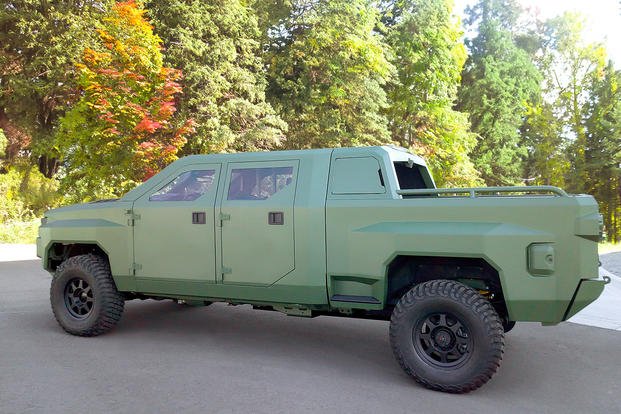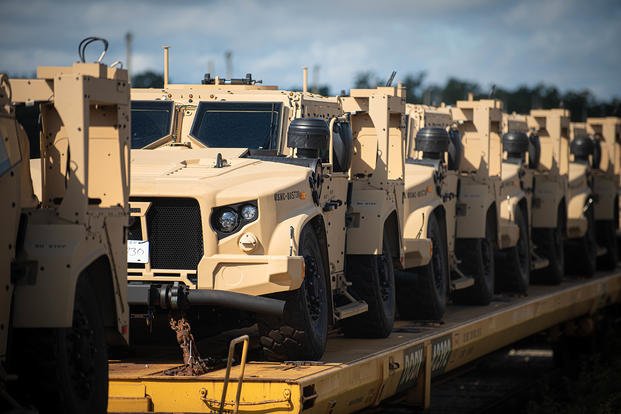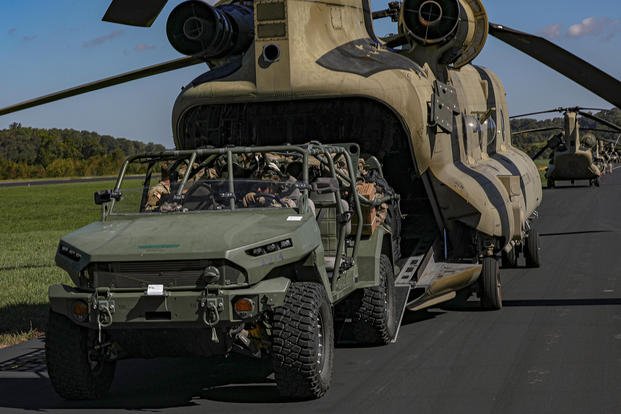Each year, senior Army leaders and the various would-be Tony Starks of the global defense industry meet to opine on leadership, plans for the future and hot, new military technology. The event is the Association of the United States Army (AUSA) annual meeting, and this year, it served as the launchpad for the latest prototype from GM Defense.
Amid seminars and trade-show booths, General Motors military subsidiary GM Defense pulled the curtain on a new prototype the company describes as a next-generation tactical vehicle. There isn’t a lot of publicly available information about this vehicle, but we at least know it won’t go down as the worst militarized truck of the year.
Let’s see what this “next-gen” pickup is all about and explore where and how it might fit into the U.S. military’s stable of wheeled vehicles.
The Chevy Silverado Is Going Green
General Motors has been busy rolling out electric and hybrid-electric trucks, including pickups and the newly reborn Hummer. The automaker is doing more than going green in the environmental sense, though — there’s olive drab in the mix.
According to a GM Defense release, the company’s new hybrid pickup can support front-line service members with command and control, launched effects, network extension, counter unmanned aerial systems, anti-armor and casualty evacuation capabilities.
The bones of this truck come from Chevy’s snazzy new Silverado 2500 HD ZR2, and it will come in two-, four- and six-seat cab configurations.
Power comes from a 2.8-liter Duramax engine combined with a 12-module battery pack and separate electric drive motors at the front and rear axles. Drivers can tap into both systems for maximum power or isolate the electric powertrain for silent drive.

That hybrid powertrain does more than stretch fuel economy and extend range. With so much electric power available, the truck can provide long periods of silent watch (think surveillance, communication and climate control) without cranking over the diesel engine. It can also serve as a mobile generator for other battery-powered equipment on the battlefield.
The truck is armor-compatible and comes with other driver safety features from the factory. These include roll-over protection, anti-lock brakes, electronic stability control and 360-degree cameras that help with everything from avoiding obstacles to checking the immediate area for signs of improvised explosive devices or incoming drones.

“Next Gen fundamentally changes the discussion around modern mobility through the tactical benefits delivered by its propulsion system, including its ability to address the power gap in the formation,” John Johnson, vice president of GM Defense’s Government Solutions and Strategy Division, said in a statement. “This highly capable tactical vehicle leverages billions of dollars of investments GM has made in R&D [research and development] and innovation to enhance warfighter capability.”
Wait, I’ve Seen This One Before
Pickup trucks are not new to the battlefield — and no, I’m not just talking about the little white trucks we’ve been battling in the Middle East for decades. Remember the M1008 Commercial Utility Cargo Vehicle? Chevy built a beefed-up version of its civilian trucks to create a 1¼-ton that was even more heavy duty than the K30 trucks of the era that preceded the Chevy 3500.
As Motor Trend reports, the M1008 came with a naturally aspirated (read: fairly gutless) 6.2-liter Detroit diesel, 4.56 gearing, a Dana 60 front differential and a locking 14-bolt rear differential. In layman’s terms, it was a hefty off-roader that begged for hard use. It was great for general tasks around base, but it wasn’t cut out for combat.
GM Defense is currently pitching the Light Utility Vehicle, which is the modern heir to the M1008’s legacy. The LUV prototype boasts a 6.6-liter Duramax turbodiesel, a 10-speed Allison transmission, 37-inch tires, locking front and rear differentials, and a suite of safety features. Like the M1008, it’s better suited to support roles than front-line driving.

We’ll have to wait and see whether the U.S. military has enough interest in the concept to place an order.
Is There a Place for the Next-Generation Tactical Vehicle in the US Arsenal?
New vehicles are always exciting, but does the Army need this one?
For ages, the Humvee was the U.S. military’s end-all, be-all vehicle. In addition to giving commanders a rolling headquarters like GM Defense’s prototype can, it shuttled troops around the battlefield and patrolled the skies with low-altitude air defense systems.
Those days are over, though. The U.S. military has moved on to vehicles that are not only more advanced but more specialized than the old Humvee.

One of those is the Joint Light Tactical Vehicle from Oshkosh Defense. After some early teething problems, it’s become a powerhouse of combat capability. You want armor, weapon systems, cutting-edge technology and off-road prowess? The JLTV has all of that in spades.

When the mission requires agility instead of brute force, the Army has access to GM Defense’s Infantry Squad Vehicle. Like the LUV and next-generation tactical vehicle prototypes, it uses off-the-shelf Chevy parts. This smaller, lighter vehicle is based on the midsize Colorado instead of 2500-series trucks.
In addition to evaluating the new concept vehicle’s capabilities, decision-makers at the Pentagon will have to determine whether there is enough of a gap in the current fleet of vehicles to warrant something new.
What’s Next for the Next-Generation Tactical Vehicle
The AUSA annual meeting gives us a peek into the future of military tech. Juggernauts from across the military-industrial complex come together to show off their latest creations in hopes of earning the military’s business.

When it comes to this piece of automotive technology, GM Defense is ready to hit the ground running.
“Our warfighters deserve the latest technology that industry can offer in order to gain and maintain [a] competitive advantage over our adversaries,” Steve duMont, president of GM Defense, said. “Our Next Gen mobility solution can be customized and fielded now.”
Of course, Uncle Sam isn’t quite as nimble. People involved in planning the Army of tomorrow will have to decide whether they want this truck in the Army’s garage. If so, there will be congressional funding requests, multiple rounds of testing and miles of red tape.
We’ll keep you posted on all of that. In the meantime, active-duty Silverado owners can rest peacefully, knowing they’ve got the coolest Chevy on base — for now.
Want to Know More About the Military?
Be sure to get the latest news about the U.S. military, as well as critical info about how to join and all the benefits of service. Subscribe to Military.com and receive customized updates delivered straight to your inbox.
Story Continues
Read the full article here

